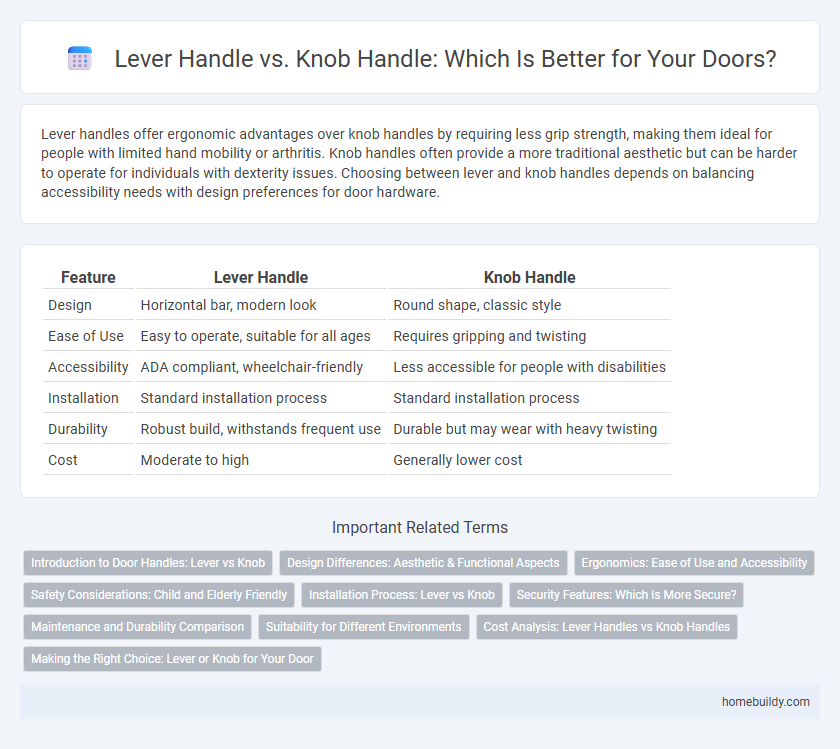Lever handles offer ergonomic advantages over knob handles by requiring less grip strength, making them ideal for people with limited hand mobility or arthritis. Knob handles often provide a more traditional aesthetic but can be harder to operate for individuals with dexterity issues. Choosing between lever and knob handles depends on balancing accessibility needs with design preferences for door hardware.
Table of Comparison
| Feature | Lever Handle | Knob Handle |
|---|---|---|
| Design | Horizontal bar, modern look | Round shape, classic style |
| Ease of Use | Easy to operate, suitable for all ages | Requires gripping and twisting |
| Accessibility | ADA compliant, wheelchair-friendly | Less accessible for people with disabilities |
| Installation | Standard installation process | Standard installation process |
| Durability | Robust build, withstands frequent use | Durable but may wear with heavy twisting |
| Cost | Moderate to high | Generally lower cost |
Introduction to Door Handles: Lever vs Knob
Lever handles offer ergonomic advantages with easier grip and operation, making them suitable for accessibility compliance and frequent use. Knob handles provide a traditional aesthetic and compact design, often preferred for residential interior doors with less frequent access needs. Both types vary in installation complexity and mechanical reliability, influencing choice based on user preference and door function.
Design Differences: Aesthetic & Functional Aspects
Lever handles offer a sleek, contemporary design that enhances accessibility with ergonomic grip and ease of use, especially for individuals with limited hand strength. Knob handles feature a classic, rounded shape that complements traditional interiors but may require more wrist rotation and grip strength for operation. The choice between lever and knob handles impacts both aesthetic appeal and functional convenience in residential and commercial spaces.
Ergonomics: Ease of Use and Accessibility
Lever handles offer superior ergonomics by requiring minimal grip strength and wrist movement, making them easier to operate for individuals with arthritis or limited hand mobility. Knob handles often demand a tighter grasp and more precise finger coordination, posing challenges for people with disabilities or the elderly. Lever handles also provide better accessibility in compliance with ADA standards, enhancing usability across diverse user groups.
Safety Considerations: Child and Elderly Friendly
Lever handles offer enhanced safety for children and elderly users due to their ease of operation with minimal grip strength, reducing the risk of injury during emergencies. Knob handles may pose challenges for individuals with arthritis or limited hand mobility, potentially leading to difficulty in quick exit or entry. Choosing lever handles improves accessibility and safety in homes requiring child-proofing or elderly-friendly features.
Installation Process: Lever vs Knob
Lever handles typically offer a more straightforward installation process due to their ergonomic design and standardized mounting hardware, which aligns easily with door lock mechanisms. Knob handles often require precise alignment of internal components and may need additional adjustments to ensure smooth rotation and secure fitting. Both handle types demand attention to door thickness and latch compatibility, but lever handles generally reduce installation complexity and time.
Security Features: Which Is More Secure?
Lever handles often provide enhanced security due to their compatibility with advanced locking mechanisms such as keyless entry systems and integrated deadbolts, making unauthorized access more difficult. Knob handles, while commonly used, typically feature simpler locking systems that can be more vulnerable to picking or forced entry. Choosing between a lever and knob handle hinges on the security needs of the environment, with lever handles generally offering superior protection in commercial and high-security residential settings.
Maintenance and Durability Comparison
Lever handles typically offer easier maintenance due to fewer moving parts and simpler mechanisms compared to knob handles, which often contain more intricate components prone to wear. Durability-wise, lever handles are generally more robust under frequent use and provide better resistance to mechanical failure, especially in commercial settings. Knob handles, while aesthetically versatile, may require more frequent lubrication and parts replacement to maintain smooth operation over time.
Suitability for Different Environments
Lever handles offer superior accessibility and ease of use, making them ideal for commercial, healthcare, and elderly care settings where compliance with ADA standards is essential. Knob handles are better suited for residential environments or areas where space constraints require compact hardware, providing a traditional aesthetic. Environmental factors such as moisture exposure or frequent use can influence the durability and maintenance requirements of each handle type.
Cost Analysis: Lever Handles vs Knob Handles
Lever handles generally have a higher upfront cost compared to knob handles due to their more complex design and manufacturing process. Knob handles are often more budget-friendly, making them a popular choice for large-scale or cost-sensitive projects. However, lever handles may offer better accessibility and ergonomic benefits, potentially reducing long-term expenses in commercial or public buildings.
Making the Right Choice: Lever or Knob for Your Door
Lever handles offer ergonomic advantages, making them ideal for accessibility and ease of use, especially for children or those with limited hand strength. Knob handles provide a classic aesthetic and are less prone to accidental opening, often preferred for decorative interior doors. Choosing between lever and knob handles depends on balancing functionality, style, and user needs to ensure optimal door operation and safety.
Lever handle vs Knob handle Infographic

 homebuildy.com
homebuildy.com